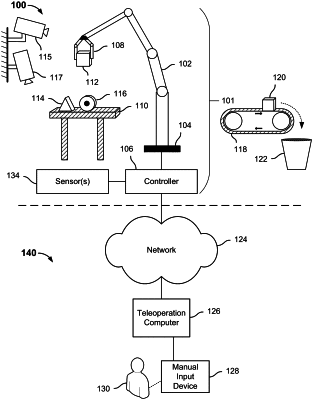| CPC B25J 9/1697 (2013.01) [B25J 9/1612 (2013.01); B25J 9/1674 (2013.01); B25J 9/1687 (2013.01); B25J 9/1689 (2013.01); B25J 9/1692 (2013.01); G06T 7/12 (2017.01); G06T 7/13 (2017.01); G06T 7/55 (2017.01); G06T 7/70 (2017.01); G06T 2207/10028 (2013.01)] | 16 Claims |

|
1. A method, comprising:
determining, based on visual data received from a plurality of cameras, a set of one or more potentially graspable features for one or more objects present in a workspace area, wherein the visual data received from the plurality of cameras is used to determine negative space information associated with the one or more objects;
determining for each of at least a subset of the one or more potentially graspable features one or more corresponding grasp strategies to grasp a feature with a robotic arm and end effector, wherein a first graspable feature of the one or more potentially graspable features includes a void that is determined based on the determined negative space information associated with the one or more objects;
determining with respect to each of a least a subset of said one or more corresponding grasp strategies a score associated with a probability of a successful grasp of a corresponding feature;
selecting to grasp a first feature of the one or more potentially graspable features using a selected grasp strategy based at least in part on a corresponding score associated with the selected grasp strategy with respect to the first feature; and
controlling the robotic arm and end effector to attempt to grasp the first feature using the selected grasp strategy, wherein grasping the first feature using the selected grasp strategy comprises:
determining whether a grasp of the first feature is successful, wherein in response to a determination that the grasp of the first feature is determined not to be successful, iteratively re-attempting to grasp the first feature using the selected grasp strategy or implementing a different grasp strategy to grasp the first feature until a threshold number of attempts to grasp the first feature have been attempted; and
in response to the threshold number of attempts having been attempted, selecting a second feature of the one or more potentially graspable features to grasp.
|